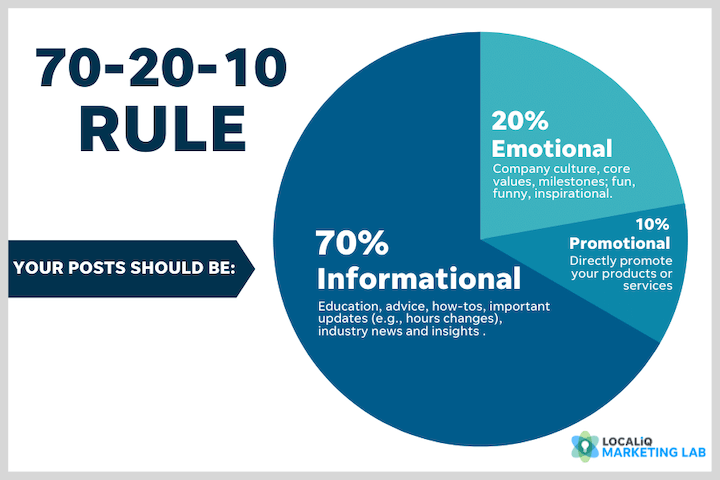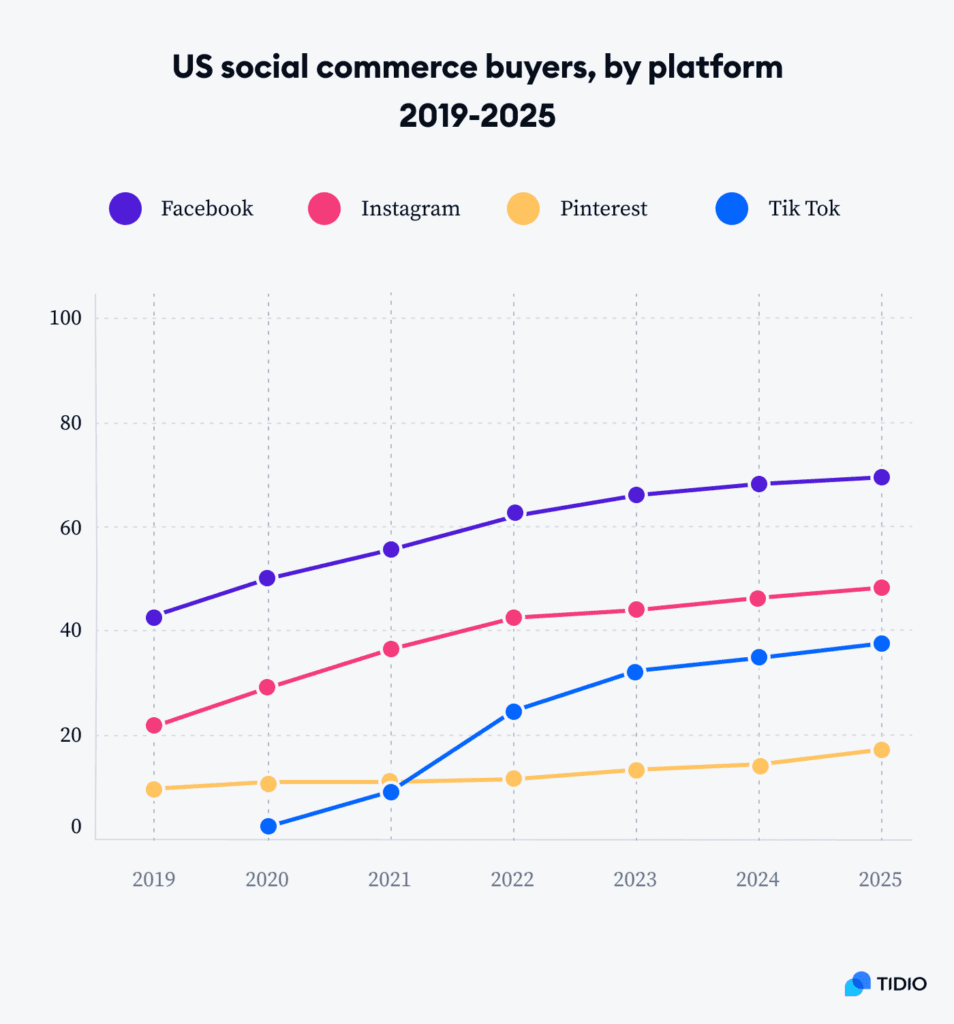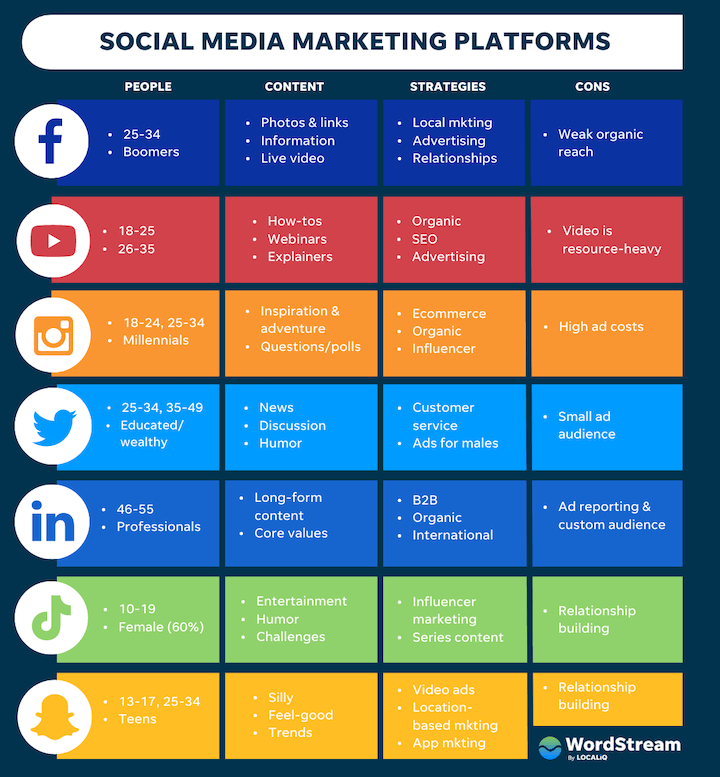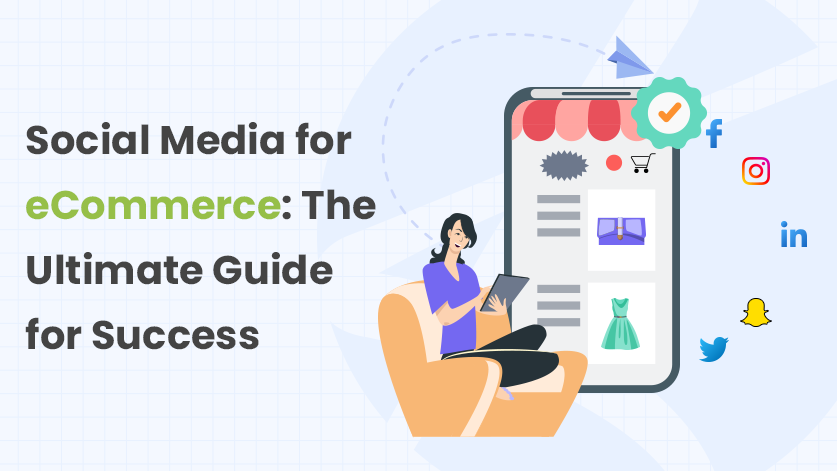In this post, we’ll talk about how to use social media to help your eCommerce business grow. With the rise of social media, eCommerce businesses have a new way to connect with their customers and build lasting relationships.
Despite this change, many eCommerce businesses don’t use social media to their advantage. A recent study found that only 22% of eCommerce businesses are getting the most out of social media.
So, what are the best ways to use social media for eCommerce business? Read on to find out.
What is Social Media eCommerce?
The process of selling your products or services through your social media profiles is known as social eCommerce.
You can do this using platforms like Instagram, Facebook, Twitter, Pinterest, and TikTok. These social media platforms offer unique features to put your products or services in front of your potential audience.
- One of the most common ways to market a business on social media is through paid ads. Businesses can reach the exact people (i.e., target audience ) they want to with their product or service through paid ads. For instance, Facebook lets businesses reach out to users based on their location, age, gender, interests, and more.
- Another popular method of using social media for eCommerce marketing is organic posts. Organic posts are those that companies publish on their social media pages without having to pay for them. Although these posts can be used to advertise products or services, they are less likely to be viewed by potential buyers than sponsored advertisements.
- Another strategy you can use is Influencer marketing on social media. Influencers are persons with a sizable social media following who can help advertise your company to their followers. You may reach more potential customers and generate awareness about your product or service by collaborating with an influencer.
What is the Role of Social Media in eCommerce?
There are many ways in which social media can help improve eCommerce. Some of these include:
1. Increased Traffic: Using social media sites like Facebook and Twitter, businesses can now reach a wider audience than ever before. This greater visibility may result in more visitors to their website and, ultimately, more sales.
2. Improved Customer Engagement: Businesses now have a platform to interact directly with their customers thanks to social media. By doing this, they can win clients’ trust and loyalty, which may lead to increased sales in the future.
3. Greater Brand Recognition: When businesses use social media well, they can get more customers to acknowledge their brands. This makes it more likely that people will remember their name and logo, which will help them make more money in the future.
How Social Media Affects eCommerce?
A decade ago, social media was mostly just a way for friends and family to keep in touch. But now, social media can be a powerful way to market your business. Social media can be a great way to bring more people to your eCommerce website and boost your sales.
Social networking is becoming an important part of how people buy things online. Next, let’s talk about the role of social media in eCommerce sales/marketing.
What are the Benefits of Social Media in eCommerce?
You might want to use social media for eCommerce marketing for several reasons. Some of the benefits include:
- It’s free! (of course, Paid ads exist but still) Social media marketing is cost-free, in contrast to conventional marketing strategies like TV or print advertisements.
- It’s effective! Studies have shown that social media is one of the most effective ways of driving website traffic.
- It’s global! According to studies, one of the best strategies for increasing website traffic is social networking.
Social Media eCommerce Statistics:

As has already been said, the use of social media for eCommerce is growing quickly as more and more companies start selling goods and services on these platforms.
We’ll look at some interesting social media eCommerce data and discuss what it says about the future of online shopping.
Shopify says over half of all online purchases are now made through social media channels. This was a huge increase from two years ago when only one-third of online purchases were made through social media.
According to eMarketer, social commerce sales in the United States alone will more than double from 2020 to 2023, surpassing $56 billion. Global sales will exceed $1 trillion in 2023 and surpass $2 trillion by 2025.
Mobile devices generate the majority of social media eCommerce sales. Mobile devices now generate 56% of all social media sales. This is due to the increasing number of people using their smartphones and tablets to make online purchases.
Facebook is still the most important social media site for online shopping. In a survey done by Magento and Hootsuite together, more than six out of ten people said that Facebook and YouTube influence one-quarter of their online purchases. According to statistics, around 34% of Instagram users will make a purchase on the platform in 2023.

Snapchat is also becoming increasingly popular as a platform for social media eCommerce transactions. It has been estimated that 31% of all American teenagers have used Snapchat to make online purchases.
Furthermore, Snapchat users have a staggering $4.4 trillion worldwide spending power. This figure is likely to grow in the coming years as Snapchat’s popularity continues to rise.
Some of the Most Popular Social Media Platforms:

1. Facebook (2.9 billion users by 2022)
Using your Facebook Page to advertise your products and services is one of the easiest ways to use social media for eCommerce. You can set up an online store right on your page, run promotions, and write news about your products. Easy peasy!
2. Twitter (450 million users by 2022)
Twitter is another great place to promote products and services online. You can tweet about sales, post pictures of your products, and even add videos of how to use your products or customer reviews.
3. Pinterest (445 million users by 2022)
Pinterest is a social networking site for sharing pictures, and it’s a great place to promote online stores. Companies can make boards that show off their products, add information like prices and descriptions, and even add pins from their website or online store.
4. Instagram (2 billion users by 2022)
Instagram is a great tool for advertising online stores. Brands can publish pictures of their products, storefronts, or product packaging and hold photo contests with cash prizes. Instagram also has its own shop.
5. LinkedIn (900 million users by 2022)
LinkedIn is a site for professionals to connect with each other, and it can be used to market eCommerce businesses effectively. Brands can connect with potential customers who might be interested in buying their products or services through LinkedIn groups.
Brands can use LinkedIn Company Pages to share news, articles, videos, images, etc., about what they do, as well as their contact information so that people can easily get in touch with them if they need something specific.
Overall, all of these platforms give brands different ways to reach out to and interact with people who don’t already know them while also subtly selling them things.
How to use Social Media for eCommerce?
The importance of eCommerce websites and social media to boost your business cannot be understated. However, since this marketing model is relatively new, businesses usually fail to use them effectively. Here are ways that brands can use social media for eCommerce:
1. Use Social Media to Drive Traffic to Your Website:
One of the best ways to use social media for eCommerce is to get people to visit your website from your social media pages.
You can do this by putting links to your website on your social media profiles and posts, embedding videos or pictures of your products on your pages, and holding contests or giveaways that require people to visit your website.
2. Sell Products and Services Directly on Social Media Platforms:
You can also sell products directly through social media platforms. This gets rid of the need for people who want to buy your products to go to your website email or call you.
All they need is an account on the right social media site to buy what they need without having to leave the site.
This can be done with tabs that can be changed on Facebook Pages, buy buttons that are built into tweets, or special deals that can only be found in direct messages.
If you want to sell on Instagram with shoppable posts, here is a detailed guide on how to sell on Instagram with shoppable posts using Shopify.
3. Create Branded Shopping Experiences on Social Media:
Making branded shopping experiences on social media platforms is becoming more and more popular among brands that want to use social media for eCommerce.
Setting up separate accounts or websites for selling products online and using creative methods like live video streaming or 360-degree product views are ways to do this.
4. Optimize Your Posts for Sale Conversions:
It’s important to make sure your posts about your products and services are properly optimized if you want them to lead to sales. This includes strategically using hashtags, tagging the right people/brands, adding calls to action all over your text, and making high-quality visuals that show off your brand well.
5. Use Influencers to Promote Your Products:
Working with influencers- individuals with a large number of followers- who are willing to promote your products or services in exchange for money is a good way to use social media for eCommerce.
6. Share Customer Testimonials:
One of the best ways to build trust with possible customers is to share customer testimonials on social media sites like Facebook and Twitter.
This shows possible customers that your business has been good for other people.
7. Integrate Social Media into Your Website:
Adding social media to your website is another way to use social media for eCommerce. This lets people buy products and services from your site without having to leave their homes.
8. Host Online Giveaways and Contests:
Online giveaways and contests are another popular way that brands use social media for eCommerce. By doing a simple task, these contests give people a chance to win free products or gift cards (like following your page or adding a sale hashtag).
9. Use Social Media as a Customer Service Tool:
You can also help customers with social media. This means answering questions and complaints from customers quickly and taking care of their problems quickly. You can also offer live chat support on social media sites so that customers can quickly and easily get answers.
10. Use Social Media to Build Customer Loyalty:
One of the best things about social media is that it lets you build customer loyalty by giving them a better experience than they would get in a store. You can do this by offering special deals, discounts, and free shipping on orders over a certain amount.
11. Optimize Your Posts for Sale Conversions:
It’s important to make sure your posts about your products and services are properly optimized if you want them to lead to sales. This includes strategically using hashtags, tagging the right people/brands, adding calls to action all over your text, and making high-quality visuals that show off your brand well.
How to Find Social Media Content Ideas for eCommerce?
Here we will explore five methods you can use to find social media content ideas for your eCommerce business.
1. Use Trending Topics as Inspiration:
One of the best ways to come up with new ideas for content is to look at what’s popular at the moment. You can use Google Trends or Twitter’s hashtag tool to find out what these are.
Once you know what people are talking about, you can make content for your followers that is relevant and interesting.
2. Take Advantage of User-Generated Content:
User-generated content (UGC) is content that is made by users, not by brands. This could include anything from customer reviews and testimonials to photos and videos uploaded by customers.
UGC not only helps cut down on marketing costs, but it also helps customers trust and believe in your business. Why not use this useful resource and share it with your followers?
3. Leverage of Social Media Contest Ideas:
Social media contests are a great way to get your followers interested and involved. They can be as easy as a photo contest or as hard as a scavenger hunt or quiz. No matter what format you choose, make sure the prize is appealing enough to get people to enter.
4. Repurpose Existing Content:
When it comes to making content for social media, less is sometimes more. If you don’t have the time or inspiration to come up with new ideas, why not turn interesting blog posts or articles you’ve already written into posts for social media? This method doesn’t take much work, but it can still get a lot of interaction from your followers.
5. Use Competitor Pages:
Look at the pages of your competitors to get ideas for what to write about. Check out what kind of posts they make and which ones get the most comments (likes, shares, comments). Try to make content that is similar but has your own twist.
How Not To Use Social Media For eCommerce Marketing?
Here are five of the biggest mistakes people make when using social media for eCommerce and why they can damage your business.
1. Not Having a Strategy:
Not having a plan is one of the worst things you can do when using social media for eCommerce. If you don’t have a plan, you’ll probably waste time and money on campaigns that don’t work.
2. Focusing on Quantity Over Quality:
When it comes to social media marketing, it’s important to remember that quality always beats quantity. If you spam low-quality content to your followers, it will hurt your brand in the long run.
3. Not Targeting the Right Audience:
Another mistake that businesses often make with their social media ads is that they try to reach the wrong people. If you don’t target the right people, you could lose money on clicks and impressions that don’t matter.
4. Neglecting Paid Ads:
Paid advertising on social media is something that many businesses don’t do, which is a big mistake. Paid ads let you target customers who are interested in your business and get more leads at a lower cost than SEO or email marketing.
Undoubtedly, the most beneficial way of leveraging paid ads on social media these days is using TikTok. It is a real game-changer and is capable of boosting your eCommerce business to a new height. Making TikTok ads is not either complex or time-consuming and you only need some fundamental knowledge to know how to advertise on TikTok.
5. Failing to Measure Results:
Lastly, when businesses use social media for eCommerce, one of the most common mistakes they make is not measuring their results correctly. Without proper tracking and analysis, you can’t tell if your campaigns are working or not.
Conclusion:
In conclusion, social media is a powerful tool that you can use to grow your eCommerce business. You can reach more people and make more sales if you make interesting content, build relationships with people who have a lot of influence, and run ads.
Feel free to contact us if you have more questions about how to use social media for eCommerce.








